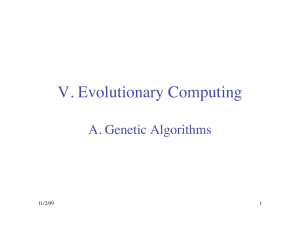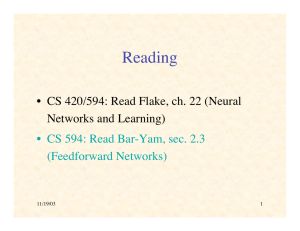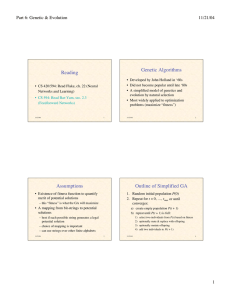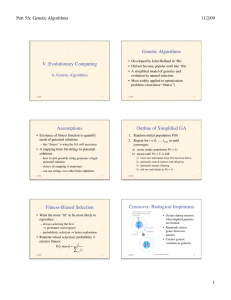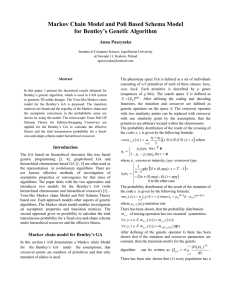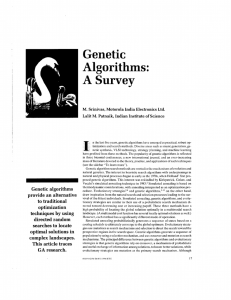B." Genetic Algorithms! 10/26/08! 1!
advertisement
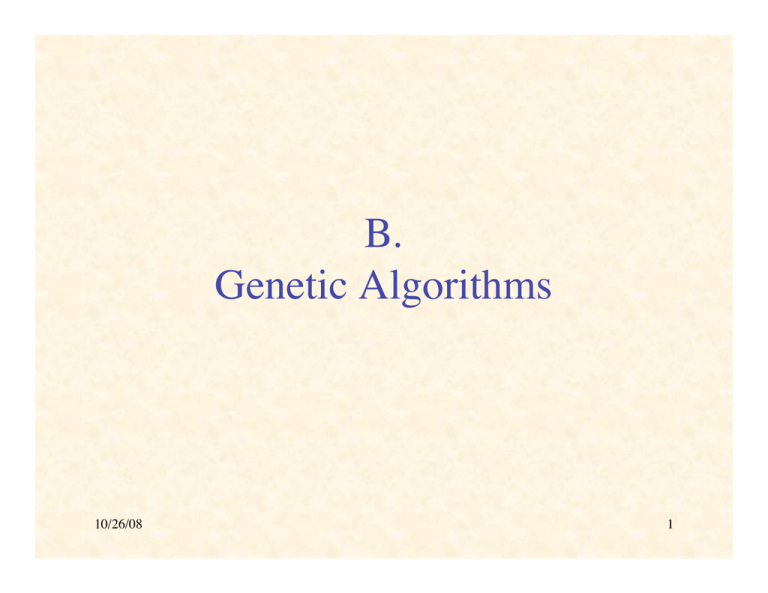
B."
Genetic Algorithms!
10/26/08!
1!
Genetic Algorithms!
•! Developed by John Holland in ‘60s!
•! Did not become popular until late ‘80s!
•! A simplified model of genetics and
evolution by natural selection!
•! Most widely applied to optimization
problems (maximize “fitness”)!
10/26/08!
2!
Assumptions!
•! Existence of fitness function to quantify
merit of potential solutions!
–! this “fitness” is what the GA will maximize!
•! A mapping from bit-strings to potential
solutions!
–! best if each possible string generates a legal
potential solution!
–! choice of mapping is important!
–! can use strings over other finite alphabets!
10/26/08!
3!
Outline of Simplified GA!
1.! Random initial population P(0)!
2.! Repeat for t = 0, …, tmax or until
converges:!
a)! create empty population P(t + 1)!
b)! repeat until P(t + 1) is full:!
1)!
2)!
3)!
4)!
10/26/08!
select two individuals from P(t) based on fitness!
optionally mate & replace with offspring!
optionally mutate offspring!
add two individuals to P(t + 1)!
4!
Fitness-Biased Selection!
•! Want the more “fit” to be more likely to
reproduce!
–! always selecting the best "
! premature convergence!
–! probabilistic selection ! better exploration!
•! Roulette-wheel selection: probability "
relative fitness:!
fi
Pr{i mates} = n
"
10/26/08!
j=1
fj
5!
Crossover: Biological Inspiration!
•! Occurs during meiosis,
when haploid gametes
are formed!
•! Randomly mixes
genes from two
parents!
•! Creates genetic
variation in gametes!
10/26/08!
(fig. from B&N Thes. Biol.)!
6!
GAs: One-point Crossover!
parents!
10/26/08!
offspring!
7!
GAs: Two-point Crossover!
parents!
10/26/08!
offspring!
8!
GAs: N-point Crossover!
parents!
10/26/08!
offspring!
9!
Mutation: Biological Inspiration!
•! Chromosome mutation !!
•! Gene mutation: alteration
of the DNA in a gene!
–! inspiration for mutation in
GAs!
•! In typical GA each bit has
a low probability of
changing!
•! Some GAs models
rearrange bits!
10/26/08!
(fig. from B&N Thes. Biol.)!
10!
Example: GA for IPD!
•! Genetic strings encode strategy!
–! for first round!
–! based on self’s & opponent’s action on r
previous rounds!
–! hence 22r + 1 bits!
•! E.g., for r = 1:!
opp. cooperated!
opp. defected!
we cooperated!
first round!
opp. defected!
opp. cooperated!
10/26/08!
we defected!
11!
Typical Result!
convergence!
10/26/08!
12!
The Red Queen Hypothesis!
“Now, here, you see, it takes "
all the running you can do, "
to keep in the same place.”"
— Through the Looking-Glass!
and What Alice Found There!
10/26/08!
•! Observation: a species
probability of extinction is independent of
time it has existed!
•! Hypothesis: species
continually adapt to
each other!
•! Extinction occurs with
insufficient variability
for further adaptation!
13!
Reading!
•! Read Flake, ch. 17, “Competition &
Cooperation”!
10/26/08!
14!
Demonstration of GA:"
Finding Maximum of"
Fitness Landscape!
Run Genetic Algorithms — An Intuitive
Introduction"
by Pascal Glauser"
<www.glauserweb.ch/gentore.htm>!
10/26/08!
15!
Demonstration of GA:"
Evolving to Generate"
a Pre-specified Shape"
(Phenotype)!
Run Genetic Algorithm Viewer"
<www.rennard.org/alife/english/gavgb.html>!
10/26/08!
16!
Demonstration of GA:"
Eaters Seeking Food!
http://math.hws.edu/xJava/GA/!
10/26/08!
17!
Morphology Project"
by Michael “Flux” Chang!
•! Senior Independent Study project at UCLA!
–! users.design.ucla.edu/~mflux/morphology!
•! Researched and programmed in 10 weeks!
•! Programmed in Processing language!
–! www.processing.org!
10/26/08!
18!
Genotype ! Phenotype!
•! Cells are “grown,” not specified individually!
•! Each gene specifies information such as:!
–! angle!
–! distance!
–! type of cell!
–! how many times to replicate!
–! following gene!
•! Cells connected by “springs”!
•! Run phenome:
!
<users.design.ucla.edu/~mflux/morphology/gallery/sketches/phenome>
10/26/08!
19!
Complete Creature!
•! Neural nets for control (blue)!
–! integrate-and-fire neurons!
•! Muscles (red)!
–! decrease “spring length” when fire!
•! Sensors (green)!
–! fire when exposed to “light”!
•! Structural elements (grey)!
–! anchor other cells together!
•! Creature embedded in a fluid!
•! Run <users.design.ucla.edu/~mflux/morphology/gallery/sketches/creature>!
10/26/08!
20!
Effects of Mutation!
•!
•!
•!
•!
•!
•!
Neural nets for control (blue)!
Muscles (red)!
Sensors (green)!
Structural elements (grey)!
Creature embedded in a fluid!
Run
!
<users.design.ucla.edu/~mflux/morphology/gallery/sketches/creaturepack>
10/26/08!
21!
•! Population: 150–200!
•! Nonviable & nonresponsive creatures
eliminated!
•! Fitness based on
speed or light-following!
•! 30% of new pop. are
mutated copies of best!
•! 70% are random!
•! No crossover!
10/26/08!
Evolution!
22!
Gallery of Evolved Creatures!
•! Selected for speed of movement!
•! Run
!
<users.design.ucla.edu/~mflux/morphology/gallery/sketches/creaturegallery>
10/26/08!
23!
Why Does the GA Work?!
The Schema Theorem!
10/26/08!
24!
Schemata!
A schema is a description of certain patterns
of bits in a genetic string!
. . .!
1 1 0 0 0 0!
. . .!
1 1 1 0 1 0!
a schema"
1 1 0 0 0 1!
describes"
many strings!
10/26/08!
* * * * * 0!
* * 0 * 1 *!
1 1 * 0 * *!
1 1 0 * 1 0!
1 1 0 0 1 0!
1 1 0 0 1 0!
a string"
belongs to"
many schemata!
25!
The Fitness of Schemata!
•! The schemata are the building blocks of
solutions!
•! We would like to know the average fitness
of all possible strings belonging to a schema!
•! We cannot, but the strings in a population
that belong to a schema give an estimate of
the fitness of that schema!
•! Each string in a population is giving
information about all the schemata to which
it belongs (implicit parallelism)!
10/26/08!
26!
Effect of Selection!
Let n = size of population
Let m( S,t ) = number of instances of schema S at time t
!
!
!
String i gets picked with probability
"
j
fj
Let f ( S ) = avg fitness of instances of S at time t
So expected m( S,t + 1) = m( S,t ) " n "
!
Since f av =
!
fi
10/26/08!
"
j
n
fj
f ( S)
#
j
fj
f ( S)
, m( S,t + 1) = m( S,t )
f av
27!
Exponential Growth!
•! We have discovered:"
m(S, t+1) = m(S, t) # f(S) / fav !
•! Suppose f(S) = fav (1 + c)!
•! Then m(S, t) = m(S, 0) (1 + c)t !
•! That is, exponential growth in aboveaverage schemata!
10/26/08!
28!
Effect of Crossover!
**1 … 0***!
|'%(|)
•! Let $ = length of genetic strings!
•! Let %(S) = defining length of schema S !
•! Probability {crossover destroys S}:"
pd & %(S) / ($ – 1)!
•! Let pc = probability of crossover!
•! Probability schema survives:!
$ ( S)
ps " 1# pc
%#1
10/26/08!
29!
Selection & Crossover Together!
f ( S) &
$ (S ) )
m( S,t + 1) " m( S,t )
(1# pc
+
f av '
% #1*
!
10/26/08!
30!
Effect of Mutation!
•! Let pm = probability of mutation!
•! So 1 – pm = probability an allele survives!
•! Let o(S) = number of fixed positions in S !
•! The probability they all survive is"
(1 – pm)o(S) !
•! If pm << 1, (1 – pm)o(S) # 1 – o(S) pm !
10/26/08!
31!
Schema Theorem:"
“Fundamental Theorem of GAs”!
)
f ( S) &
$ (S )
m( S,t + 1) " m( S,t )
# o( S ) pm +
(1# pc
f av '
% #1
*
!
10/26/08!
32!
The Bandit Problem!
•! Two-armed bandit:!
–! random payoffs with (unknown) means m1, m2
and variances *1, *2 !
–! optimal strategy: allocate exponentially greater
number of trials to apparently better lever!
•! k-armed bandit: similar analysis applies!
•! Analogous to allocation of population to
schemata!
•! Suggests GA may allocate trials optimally!
10/26/08!
33!
Goldberg’s Analysis of
Competent & Efficient GAs!
10/26/08!
34!
Paradox of GAs!
•! Individually uninteresting operators:!
–! selection, recombination, mutation!
•! Selection + mutation ! continual
improvement!
•! Selection + recombination ! innovation!
–! fundamental to invention: "
generation vs. evaluation!
•! Fundamental intuition of GAs: the three
work well together!
10/26/08!
35!
Race Between Selection &
Innovation: Takeover Time!
•! Takeover time t* = average time for most fit
to take over population!
•! Transaction selection: population replaced
by s copies of top 1/s"
•! s quantifies selective pressure!
•! Estimate t* # ln n / ln s !
10/26/08!
36!
Innovation Time!
•! Innovation time ti = average time to get a
better individual through crossover &
mutation!
•! Let pi = probability a single crossover
produces a better individual!
•! Number of individuals undergoing
crossover = pc n !
•! Probability of improvement = pi pc n !
•! Estimate: ti # 1 / (pc pi n)!
10/26/08!
37!
Steady State Innovation!
•! Bad: t* < ti !
–! because once you have takeover, crossover
does no good!
•! Good: ti < t* !
–! because each time a better individual is
produced, the t* clock resets!
–! steady state innovation"
•! Innovation number:!
t*
n ln n
Iv = = pc pi
>1
ti
ln s
10/26/08!
38!
Feasible Region!
pc"
successful!
genetic algorithm!
cross-competition!
boundary!
drift boundary!
crossover probability!
schema theorem boundary!
mixing boundary!
selection pressure!
10/26/08!
ln s!
39!
Other Algorithms Inspired by
Genetics and Evolution!
•! Evolutionary Programming!
–! natural representation, no crossover, time-varying
continuous mutation!
•! Evolutionary Strategies!
–! similar, but with a kind of recombination!
•! Genetic Programming!
–! like GA, but program trees instead of strings!
•! Classifier Systems!
–! GA + rules + bids/payments!
•! and many variants & combinations…!
10/26/08!
40!
Additional Bibliography!
1.! Goldberg, D.E. The Design of Innovation:
Lessons from and for Competent Genetic
Algorithms. Kluwer, 2002.!
2.! Milner, R. The Encyclopedia of
Evolution. Facts on File, 1990.!
VI!
10/26/08!
41!
